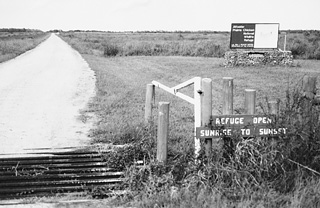Day Trips
By Gerald E. McLeod, Fri., May 30, 2003

National Wildlife Refuges around the country are celebrating their 100th anniversary this year. There are 14 of these wilderness areas in Texas, each preserving a unique slice of ecology, and most open to the public to enjoy and appreciate.
Administered by the U.S. Fish and Wildlife Service of the Department of the Interior, there are 540 refuges established since 1903 in all 50 states. At 95 million acres, the world's largest wildlife conservation system includes less than a million acres in Texas. This does not include national seashores, forests, grasslands, and other protected areas.
Anahuac NWR, east of Houston on the upper Gulf Coast, protects a valuable fowl habitat. The 12 miles of gravel roads provide an opportunity to see wildlife, and there are hiking trails and boat ramps in the sanctuary. Facilities are minimal and mosquitoes are ever-present. The entrance to the refuge is about 14 miles south of I-10. (409/267-3337)
Whooping cranes can often be seen from the observation tower in the Aransas NWR from late October to mid-April. Visitors can enjoy a 16-mile driving tour, trails, and the Interpretive Center. The sanctuary is about 36 miles north of Rockport off I-35. (361/286-3559)
The Attwater Prairie Chicken NWR is one of the few refuges operated specially for an endangered species. The hiking trails and visitor center are open to the public during daylight hours. The preserve is 6.5 miles northeast of Eagle Lake off FM 3013. (979/234-3021)
The Balcones Canyonlands NWR northwest of Austin protects the habitat for the golden-cheeked warbler and the black-capped vireo. The federal service provides an observation deck off FM 1869 south of Liberty Hill and hiking trails at Doeskin Ranch off FM 1174 on the north side of Lake Travis. (512/339-9432)
Buffalo Lake NWR, southeast of Amarillo in Umbarger, protects valuable wildlife habitats on the High Plains. Along with a prairie-dog town, the park also has a picnic area, hiking trails, and auto tour. (806/499-3382)
Brazoria NWR protects living space for 425 wildlife species on the coast east of the Angleton and Lake Jackson area. The refuge is open daily September through May and on the first full weekend of the month during the summer. The auto tour leads to observation platforms, trails, a photo blind, and a picnic area. (979/849-7771)
Hagerman NWR in northeast Texas offers hiking trails and a driving tour across the prairie to delicate wetlands. (903/786-2826)
Laguna Atascosa NWR outside of Rio Hondo is the largest protected area left in the Lower Rio Grande Valley. The two tour roads are open during daylight as are the six hiking trails. Bicycling is allowed on the service roads, and there is a fee charged for entry to the park. (956/748-3607)
The Lower Rio Grande Valley NWR is the first 90,000 acres of a proposed 132,500-acre wildlife corridor along the river. Selected tracts of the refuge are often open to the public for hiking, hunting, canoeing, and fishing. Consult a ranger for details before entering the refuge. (956/787-3079)
McFaddin and Texas Point NWR is on the upper Texas Gulf Coast and is accessible from Sabine Pass on Highway 87. The separate tracts are quite primitive and are great fishing and canoeing places. (409/971-2909)
Muleshoe NWR is the oldest national refuge in Texas and protects a central flyway across the High Plains outside of Muleshoe northwest of Lubbock. (806/946-3341)
Santa Ana NWR was established in 1943 and protects subtropical habitats on the Lower Rio Grande delta. The visitor center outside of Alamo (the town, not the mission) is open daily 8am-4pm along with hiking trails and interpretive tram. (956/784-7500)
The San Bernard NWR south of the Lake Jackson area protects 27,414 acres of coastal prairies and woodlands accessible off FM 2918. Designated areas are open for fishing and nature observation. (979/964-3639)
Trinity River NWR is the newest addition to the system in Texas and protects hardwood bottomland along the river. Access is available at the Champion Lake public-use area outside of Liberty, 48 miles east of Houston. (936/336-9786)
Refuges around the nation will be hosting special events during the summer leading up to National Wildlife Refuge Week during the second week of October. For information on Texas sanctuaries call the individual refuges or visit the service's Web site at southwest.fws.gov/refuges/txrefuges.html.
625th in a series. Day Trips, Vol. 2, a book of Day Trips 101-200, is available for $8.95, plus $3.05 for shipping, handling, and tax. Mail to: Day Trips, PO Box 33284, South Austin, TX 78704.








